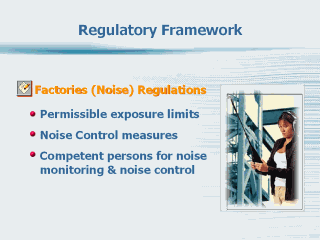| front |1 |2 |3 |4 |5 |6 |7 |8 |9 |10 |11 |12 |13 |14 |15 |16 |17 |18 |19 |review |
 |
Factories (Noise)
Regulations
A significant development was the introduction of the Factories (Noise) Regulations4 which came into effect on 1 Jan 1997. The Regulations require factory occupiers and employers to take measures to reduce or control noise so that workers are not exposed to excessive noise. The permissible exposure limits (equivalent level of 85 dBA over an 8-hour workday) and noise control measures are specified in the Regulations. New machinery and equipment with excessive noise are not allowed unless incorporated with noise control measures. Suppliers of noisy machinery and equipment must provide information on the noise level generated by their products and label them. Factories with 10 or more workers exposed to excessive noise must appoint a competent person to conduct regular noise monitoring of at least once every three years. Factories with 50 or more workers exposed to excessive noise must appoint a suitably qualified person to advise the management on noise control measures. Persons appointed for noise control and noise monitoring must attend approved training. The Regulations also require factory occupiers and employers to provide hearing protectors to all persons exposed to excessive noise. They must put up warning signs indicating that hearing protectors must be worn in areas with excessive noise. In addition, they must institute a training programme for persons exposed to excessive noise. 4. The Government of Singapore. The Factories (Noise) Regulations. The Government Printer, 1996. |